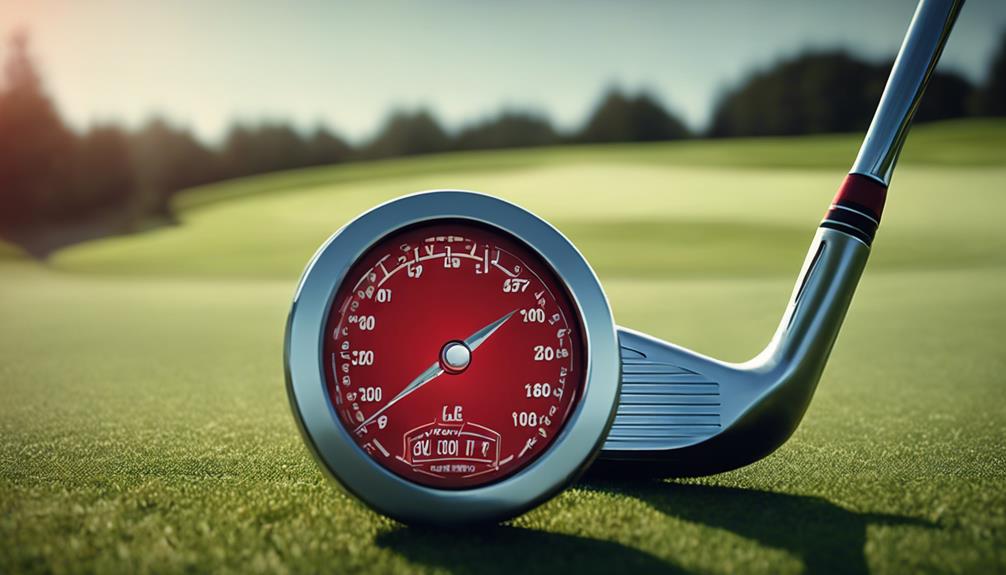- 7 Top Flite Golf Clubs XL for Improved Performance - September 28, 2024
- Top Flite Golf Clubs: Top 5 Reasons to Choose Them - September 28, 2024
- Top 3 Golf Club Fitters for a Perfect Swing - September 28, 2024
When you pick up a golf club, the 'L' inscription on the shaft may seem like a mysterious code, but it's actually a vital indicator of the club's flexibility, designed specifically for golfers with slower swing speeds, typically ladies, to help them achieve ideal launch angles and shot accuracy. The 'L' flex is one of several codes, including A/M, R, S, and X, which determine the club's flexibility level. By understanding the 'L' flex, you'll be able to make informed decisions about your golf club selection, and as you explore further, you'll uncover even more insights to take your game to the next level.
Key Takeaways
- L flex on a golf club is designed for slower swing speeds, typically for ladies, and provides more flexibility to aid in achieving optimal launch angles.
- It is essential for golfers with swing speeds under 75 mph, as it helps achieve better clubface squaring and shot accuracy.
- L flex shafts offer enhanced control and trajectory for golfers with slower swings, leading to increased confidence and improved performance.
- The L flex code indicates a more flexible shaft, which is beneficial for golfers who struggle with clubface squaring and shot consistency.
Understanding Shaft Flex Codes
When selecting a golf club, understanding shaft flex codes is crucial, as they greatly impact your game's overall performance. You need to know what the codes mean to choose the right golf equipment for your swing.
The shaft flex code is a critical component of golf clubs, and it's not just about the club's overall weight or feel. The code determines how much the shaft will flex during your swing, which affects the clubface's squaring and, ultimately, your shot's accuracy.
The classification system includes various codes, such as L, A/M, R, S, and X, each suited for different swing speeds and styles. For instance, the L flex code indicates the most flexible shaft, designed for ladies or golfers with slower swing speeds.
It's crucial to understand your required flex to optimize your performance. Misjudging your flex can lead to a preference for stiffer shafts, which can negatively impact your game.
Importance of Proper Shaft Flex
Now that you've grasped the basics of shaft flex codes, it's time to explore the importance of proper shaft flex, as it can make all the difference in your game by ensuring the clubhead reaches its ideal position at impact.
Every golfer, regardless of skill level, needs to understand that using the correct flex is essential for optimizing performance and shot accuracy.
Here are just a few reasons why proper shaft flex matters:
- Improved shot trajectory: With the right flex, you'll achieve better distance control and a more consistent ball flight.
- Better clubface squaring: Proper shaft flex helps you square the clubface at impact, resulting in more accurate shots and fewer mishits.
Swing Speed and Flex Relationship

You'll find that your swing speed plays a critical role in determining the perfect flex for your golf clubs, particularly if you're a golfer with a slower swing tempo. If your driver swing speed is under 75 mph, resulting in distances under 180 yards, an 'L' flex shaft is likely the best fit for you. This is because slower swing speeds require more flex in the shaft to achieve optimal launch angles and improve shot accuracy.
Your swing tempo also comes into play, as a smoother, slower swing may benefit from the added flexibility of an 'L' flex. When you use an 'L' flex shaft, you'll notice a significant improvement in your ability to square the clubface at impact, leading to better shot trajectories.
This is especially important when considering the lie of your clubs. Whether you have an upright lie or a standard lie, the right flex will help you maintain consistency and control throughout your swing. By matching your swing speed to the perfect flex, you'll be able to take your game to the next level and achieve the results you're looking for.
Flex Ratings and Industry Standards
Golf club manufacturers use a standardized system of flex ratings, including 'L', 'A/M', 'R', 'S', and 'X', to match the stiffness of a shaft to different swing types and speeds.
You, as a golfer, need to understand that these ratings aren't universally defined, leading to flex classification challenges. This means that an 'L' flex shaft from one manufacturer mightn't be identical in stiffness to another.
When selecting a shaft, you need to take into account the flex impact analysis on your game. A shaft that's too stiff or too flexible can greatly affect your performance.
Here are some key takeaways to keep in mind:
- Shaft performance variability is a real issue, and you need to test different options to find the right fit.
- Flex ratings can be misleading, so don't rely solely on the label.
Choosing the Right Flex for You

As you explore the world of golf, you'll encounter various shaft flex options, each with its unique characteristics.
To find the perfect fit, you need to understand flex ratings and how they impact your game.
Shaft Flex Options
When it comes to selecting the right shaft flex for your game, understanding your swing speed and style is key to optimizing performance. As a golfer, you want to guarantee you're getting the most out of your clubs, and the right shaft flex can make all the difference.
If you're a golfer with a slower swing speed, below 75 mph, an 'L' flex shaft might be the perfect option for you. This ladies flex is designed to provide enhanced club control and improved trajectory, making it easier to achieve accurate shots.
Here are just a few benefits you can expect from selecting the right shaft flex:
- Improved shot accuracy: With the right flex, you'll be able to square the clubface more consistently, leading to more accurate shots.
- Better distance control: By optimizing your shaft flex, you'll be able to achieve more consistent distances, giving you a competitive edge on the course.
Flex Ratings Explained
You're likely wondering how to decipher the various flex ratings, including the 'L' flex, to find the perfect match for your swing.
With flex technology advancements, manufacturers have developed a range of options to cater to different golfer profiles.
The key to optimizing your performance lies in selecting the right flex that complements your swing tempo and speed.
The 'L' flex, being the most flexible, is designed for golfers with slower swing speeds and shorter distances.
By using an 'L' flex shaft, you can benefit from increased whip, leading to better launch angles and improved distance.
However, it's important to note that shaft material differences can affect flex ratings, making it vital to test different options.
To find the perfect fit, consider your swing tempo and speed, and experiment with various flexes.
Remember, using a shaft that's too stiff can hinder your performance, while the right flex can reveal your full potential.
Swing Speed Matters
Determining your swing speed is essential in choosing the right flex, as it directly impacts the performance and accuracy of your shots. If you're unsure about your swing speed, consider using swing analysis techniques, such as radar guns or launch monitors, to get an accurate reading. This information is significant in selecting the right shaft flex for your game.
When it comes to choosing the right flex, remember:
- Don't sacrifice accuracy for distance: Using a shaft that's too stiff for your swing speed can result in poor shot trajectory and inconsistent performance.
- Listen to your body: Pay attention to player feedback – if you're struggling to generate power or control, it may be a sign that your shaft flex is too stiff.
Identifying Incorrect Flex Usage
As you analyze your game, you'll want to identify signs of incorrect flex usage, which can greatly impact your performance.
If you're struggling to square the clubface at impact or noticing inconsistent trajectories, it may be a sign that your shaft flex is mismatched to your swing speed and tempo.
Difficulties in Squaring Face
When your swing speed fails to match the stiffness of your shaft, squaring the clubface at impact becomes an uphill battle, leading to a string of inconsistent shots. This mismatch affects your swing mechanics, making it challenging to achieve ideal clubface alignment in the impact zone. As a result, you'll struggle to predict the trajectory and direction of the ball.
Here are some struggles you might face:
- Inconsistent ball flight patterns, making it difficult to trust your swing
- Frequent mishits, slicing, or hooking, eroding your confidence
To overcome these difficulties, it's crucial to identify signs of incorrect flex usage, such as poor alignment or frequent mishits.
By recognizing these signs, you can take the first step towards finding a more suitable shaft stiffness, like an L flex, that complements your swing speed.
With the right flex, you'll be able to square the clubface more consistently, leading to more accurate and controlled shots.
Swing Speed and Trajectory
Your swing speed plays a critical role in uncovering the ideal flex for your game, and recognizing the telltale signs of incorrect flex usage is essential to enhancing your trajectory and shot performance. A thorough swing speed analysis can help you determine if you're using the right flex for your swing.
If you're consistently hitting shots that curve excessively, either to the left or right, it may be a sign that your flex is too stiff or too soft. This can lead to a compromised trajectory, resulting in missed targets and lost distance.
To achieve optimal trajectory enhancement, you need to evaluate the flex impact on your shot shape. With an 'L' flex shaft, you can expect a higher trajectory and more forgiveness, especially if your swing speed is under 75 mph.
However, if you're swinging faster, an 'L' flex may not provide the stability you need, leading to inconsistent shots. By understanding how your swing speed affects your flex choice, you can make adjustments to enhance your trajectory and take your game to the next level.
Proper Flex Selection Matters
You can pinpoint incorrect flex usage by recognizing the telltale signs in your shot patterns, such as excessive curvature, which often stems from a mismatch between your swing speed and shaft flexibility. This mismatch can lead to difficulties in squaring the clubface, resulting in inconsistent shots.
Common signs of incorrect flex usage include:
- Slices or hooks that seem impossible to correct
- Shots that consistently fall short or run long
Don't fall victim to common misconceptions about flex selection. Many golfers, especially men, often choose stiffer shafts than necessary, which can negatively impact shot trajectory and overall performance.
Instead, focus on flex selection tips that prioritize your unique swing speed and tempo. By doing so, you'll be able to maximize your performance and reveal a more consistent, accurate game.
Shaft Flex and Swing Tempo

Golfers' swing tempo plays an essential role in determining the ideal shaft flex, as it directly affects the clubhead's speed and angle of attack.
When you swing, your tempo influences the shaft's ability to flex and recover, which in turn impacts your ball flight. Smoother swings tend to require less flex, while more abrupt or jerky swings need more flexibility to compensate for the increased swing dynamics.
As you evaluate your swing tempo, consider the tempo effects on your flex adjustments. If you have a slower swing speed, like those who benefit from an 'L' flex shaft, you'll need more flexibility to promote higher launch angles and improved ball flight.
Historical Changes in Shaft Design
As you explore the world of golf clubs, you'll notice that shaft design has undergone significant transformations over the years.
To better understand these changes, let's take a closer look at the shaft evolution timeline, which reveals how material innovations have impacted performance.
Shaft Evolution Timeline
The golf industry's shift from traditional hickory wood shafts to steel alternatives in the early 20th century marked a notable milestone in the evolution of shaft design, driven by the pursuit of increased durability and consistency.
You're likely familiar with the hickory shafts history, but the introduction of steel shafts revolutionized the game.
As you investigate the shaft evolution timeline, you'll notice:
- The 1970s brought graphite technology, which impacted the industry by offering lighter weight options that improved swing speed and distance for many golfers.
- Throughout the 1990s and 2000s, shaft technology advanced considerably with the development of multi-material shafts and improved manufacturing processes, enhancing performance and customization.
This journey has led to the modern shaft designs you see today, with a focus on precision, customization, and performance.
As you explore deeper into the world of golf shafts, you'll appreciate the historical changes that have shaped the game.
Material Innovations Impact
Historical changes in shaft design have propelled the industry towards a diverse range of materials, each engineered to optimize performance, reduce weight, and fine-tune flex ratings for a more precise fit. As a golfer, you've likely noticed the shift from traditional steel shafts to more innovative materials like graphite and composite materials. These advancements have greatly improved material performance, allowing for more precise customization to match your unique swing speed and tempo.
| Material | Advantages |
|---|---|
| Graphite | Lightweight, high flexibility, and improved feedback |
| Composite | Enhanced durability, increased strength-to-weight ratio, and tailored flex profiles |
| Steel | High stiffness, low torque, and consistent performance |
| Hybrid | Combines benefits of graphite and steel for balanced performance |
| Advanced Composites | Optimized fiber orientation, reduced weight, and enhanced feel |
These innovations have led to a better understanding of how flex impacts ball flight, enabling you to make more informed decisions when selecting equipment. With the wide range of materials available, you can now choose a shaft that perfectly suits your game, resulting in improved accuracy and overall performance.
Flex Consistency Issues
You've probably noticed that flex ratings in golf clubs haven't always been consistent, which is why understanding the evolution of shaft design is key to making sense of labels like L for ladies' flex.
The lack of a standardized industry definition for flex ratings means that the same flex code, like L, may not have uniform stiffness across different brands and models. This inconsistency can be frustrating for golfers trying to find the right shaft.
- You may find that a shaft labeled 'L' from one manufacturer feels stiffer than the same label from another.
- You might be surprised that a shaft from 10 years ago with the same flex rating feels softer than its modern counterpart.
To navigate these differences, it's crucial to test shafts from various manufacturers using flex testing methods and shaft performance analysis.
By doing so, you'll gain a deeper understanding of how each shaft performs and find the best match for your swing characteristics.
Don't rely solely on the label; instead, focus on finding the shaft that delivers the best results for your game.
Industry Variations in Flex Definitions

Frequently, golfers are surprised to discover that the 'L' flex designation doesn't mean the same thing across different manufacturers, leading to inconsistencies in shaft performance. This lack of standardization results in flex code variations, where each manufacturer interprets the 'L' flex differently.
As a golfer, you may find that the 'L' flex you're used to with one brand doesn't feel the same with another. This is particularly true for women, who may find that the 'L' designation doesn't always correspond to their specific swing characteristics or needs.
Historical changes in shaft design have expanded the range of flex options, contributing to these inconsistencies. With no universal standard, manufacturer interpretations of the 'L' flex can vary considerably, leading to swing speed discrepancies.
You may need to test various shafts to find the one that truly matches your individual swing style and speed. Remember, the 'L' flex is designed for slower swing speeds, typically under 75 mph, so it's crucial to find the right fit to optimize your game.
The Role of Club Fitting Professionals
When seeking to optimize your golf game, particularly if you're considering an 'L' flex shaft, consulting a club fitting professional can provide invaluable insights into your swing characteristics and recommend the most suitable shaft flex for your unique needs.
A club fitting professional will utilize advanced club fitting techniques, including golfer profile analysis, to assess your swing speed, tempo, and physical attributes. This information is then used to recommend the ideal shaft flex, ensuring you're getting the most out of your game.
Here are just a few benefits of working with a club fitting expert:
- Accurate recommendations: Get personalized advice on the best shaft flex for your swing, based on data-driven analysis.
- Customized equipment: Enjoy custom equipment adjustments, such as shaft length and lie angle tweaks, tailored to your unique playing style.
Optimizing Performance With Flex Selection

Optimizing your performance on the course begins with selecting the right flex, as it can greatly impact your ability to achieve consistent, accurate shots.
As a golfer, you know that ladies' performance can greatly benefit from the extra flexibility provided by 'L' flex shafts. With driver swing speeds under 75 mph and ball flights under 180 yards, you'll find that 'L' flex clubs help you square the clubface more easily, leading to improved shot accuracy.
However, choosing the wrong flex can hinder your performance. Using a stiffer shaft than necessary can prevent you from achieving ideal launch angles and distances.
To get it right, consider your swing tempo – a smoother swing may benefit from more flex, while a jerkier swing might require a stiffer option. By leveraging shaft technology and selecting the perfect flex for your swing, you can enhance swing efficiency and take your game to the next level.
Frequently Asked Questions
What Is an L Shaft?
You're considering an L shaft, which offers benefits like increased flexibility, allowing for higher launch angles and improved accuracy. Typically made from lightweight, flexible materials, L shafts cater to slower swing speeds, optimizing performance and control for your unique game.
What Does W Mean on Golf Club?
You're likely to encounter 'W' stamps on golf clubs, indicating enhanced performance features, such as wedge types with increased weight or wider soles, which affect club fitting and swing mechanics, requiring precise understanding for ideal play.
What Does P on a Golf Club Mean?
As you grip your club, imagine a precise shot landing softly on the green. The 'P' on your club stands for Pitching Wedge, offering a forgiving face, wider sole, and 44-48° loft, providing control and accuracy for shots within 100-130 yards.
Do I Really Need a Lob Wedge?
You're wondering if you really need a lob wedge, considering its benefits for high, short shots and spin control. If not, alternatives like sand wedges or gap wedges can fill the gap, but mastering lob wedge techniques can elevate your short game.
Conclusion
As you step onto the green, your golf club becomes an extension of yourself, and the 'L' on the shaft is the key to releasing your full potential.
It's the rhythm section that harmonizes your swing, ensuring a smooth tempo and precise control.
Without the right flex, your game is like a symphony without a conductor – discordant and off-beat.
By finding your perfect match, you'll be in tune with your clubs, and your game will sing.




